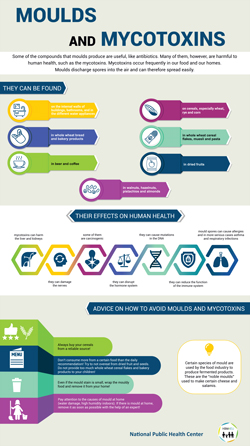 MYCOTOXINS are compounds that are produced by moulds. Moulds can occur anywhere in the natural or artificial environment. They produce different compounds, some of which are useful (e.g.: antibiotics), while many others have harmful health effects. The latter are called mycotoxins, among which some damage the kidneys and liver, others are cytoxins, neurotoxins, carcinogens, or endocrine disruptors. Some of them can cause mutagenic and immunosuppressive biological effects. At present we know of more than 400 mycotoxins, of which less than 20 have human- and animal health significance. The most important of these are the aflatoxins, ochratoxin A, the fumonisins (e.g.: fumonisin B1), the trichothecenes (e.g.: deoxynivaleon), and zearaleon. These compounds are produced mainly by members of the following fungal genera: Aspergillus, Penicillium, and Fusarium. These fungi can most often be found on grain crops, especially on wheat, rye and corn. Moulds can infect crops both on land and during storage. Mycotoxins can be found in significant concentrations in whole grains and in products made of whole grains. They can also be found in fruit-based drinks, in beer, coffee, and in many snacks (e.g.: dried fruit, peanuts, walnuts, pistachio and almond). These compounds are very resistant to different environmental effects (e.g.: heat) so they are also resistant to the different processing procedures. They can accumulate in the body if consumed. The maximum permissible concentration of mycotoxins in food products is regulated in the European Union. However, the effect of the allowed concentrations in the different food products can accumulate in the body and, according to estimates; among small children and adolescents the intake through food often exceeds the daily limit.
MYCOTOXINS are compounds that are produced by moulds. Moulds can occur anywhere in the natural or artificial environment. They produce different compounds, some of which are useful (e.g.: antibiotics), while many others have harmful health effects. The latter are called mycotoxins, among which some damage the kidneys and liver, others are cytoxins, neurotoxins, carcinogens, or endocrine disruptors. Some of them can cause mutagenic and immunosuppressive biological effects. At present we know of more than 400 mycotoxins, of which less than 20 have human- and animal health significance. The most important of these are the aflatoxins, ochratoxin A, the fumonisins (e.g.: fumonisin B1), the trichothecenes (e.g.: deoxynivaleon), and zearaleon. These compounds are produced mainly by members of the following fungal genera: Aspergillus, Penicillium, and Fusarium. These fungi can most often be found on grain crops, especially on wheat, rye and corn. Moulds can infect crops both on land and during storage. Mycotoxins can be found in significant concentrations in whole grains and in products made of whole grains. They can also be found in fruit-based drinks, in beer, coffee, and in many snacks (e.g.: dried fruit, peanuts, walnuts, pistachio and almond). These compounds are very resistant to different environmental effects (e.g.: heat) so they are also resistant to the different processing procedures. They can accumulate in the body if consumed. The maximum permissible concentration of mycotoxins in food products is regulated in the European Union. However, the effect of the allowed concentrations in the different food products can accumulate in the body and, according to estimates; among small children and adolescents the intake through food often exceeds the daily limit.
Those people who belong to the risk groups (0-5, 70+), pregnant women and those suffering from different chronic diseases that also weaken the immune system should pay attention to consume grains from reliable sources. Children in primary school and young people should also not consume too many whole grain products. If mould appears on our food we should immediately pack it up and remove it from our home. We should not try to “save” the food by removing the visible parts of the mould as the small, invisible filaments of the fungus are already present everywhere in the food product. It is important to note that mycotoxin producing fungi can also appear in our homes. We can often encounter mould on the inside walls of buildings, in our bathrooms and in our different domestic water equipment. The mycotoxins produced by these fungi enter the air in negligible amounts and do not cause significant health risk in most cases. Moulds can also produce other volatile organic compounds, the concentration of which can accumulate in closed spaces and might cause irritation in the respiratory tract. It poses a further risk that a fungus colony can release several billions of allergenic spores into the air. These spores can cause allergy and asthma. To avoid these risks we should always pay attention to the appearance of indoor moulds, the reasons for their appearance (e.g.: leak, high indoor humidity), and to their proper removal, which in some serious cases could require the help of an expert.







